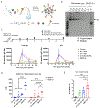Self-Assembled STING-Activating Coordination Nanoparticles for Cancer Immunotherapy and Vaccine Applications
- PMID: 38567994
- PMCID: PMC11031738
- DOI: 10.1021/acsnano.3c11374
Self-Assembled STING-Activating Coordination Nanoparticles for Cancer Immunotherapy and Vaccine Applications
Abstract
The cGAS-STING pathway plays a crucial role in innate immune activation against cancer and infections, and STING agonists based on cyclic dinucleotides (CDN) have garnered attention for their potential use in cancer immunotherapy and vaccines. However, the limited drug-like properties of CDN necessitate an efficient delivery system to the immune system. To address these challenges, we developed an immunostimulatory delivery system for STING agonists. Here, we have examined aqueous coordination interactions between CDN and metal ions and report that CDN mixed with Zn2+ and Mn2+ formed distinctive crystal structures. Further pharmaceutical engineering led to the development of a functional coordination nanoparticle, termed the Zinc-Mn-CDN Particle (ZMCP), produced by a simple aqueous one-pot synthesis. Local or systemic administration of ZMCP exerted robust antitumor efficacy in mice. Importantly, recombinant protein antigens from SARS-CoV-2 can be simply loaded during the aqueous one-pot synthesis. The resulting ZMCP antigens elicited strong cellular and humoral immune responses that neutralized SARS-CoV-2, highlighting ZMCP as a self-adjuvant vaccine platform against COVID-19 and other infectious pathogens. Overall, this work establishes a paradigm for developing translational coordination nanomedicine based on drug-metal ion coordination and broadens the applicability of coordination medicine for the delivery of proteins and other biologics.
Keywords: STING; cancer immunotherapy; coordination nanoparticle; cyclic dinucleotide; vaccine.
Figures








References
-
- Gajewski TF; Higgs EF Immunotherapy with a sting. Science 2020, 369 (6506), 921–922. - PubMed
Publication types
MeSH terms
Substances
Grants and funding
LinkOut - more resources
Full Text Sources
Medical
Research Materials
Miscellaneous

